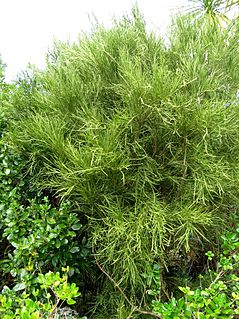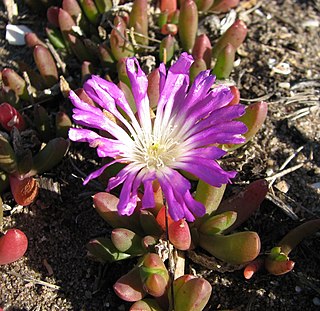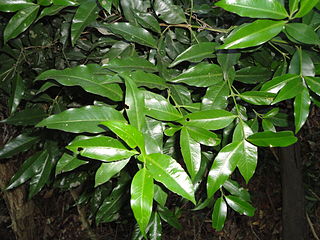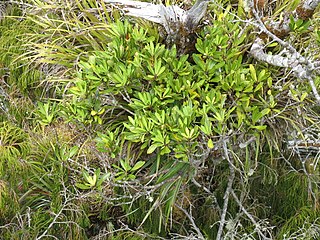
The Zanzibar red colobus is a species of red colobus monkey endemic to Unguja, the main island of the Zanzibar Archipelago, off the coast of Tanzania. It is also known as Kirk's red colobus after Sir John Kirk, the British Resident of Zanzibar who first brought it to the attention of zoological science. It is now classified as an endangered species and in the mid-1990s was adopted as the flagship species for conservation in Zanzibar. The population is still decreasing, and conservationists are attempting to work with the local government to devise a proper, effective strategy to protect the population and habitat. Challenges include the species' habitat, which is limited to the archipelago. The species has been reclassified three times; it was previously in the genus Colobus, then in the genus Procolobus, and later in the genus Piliocolobus.

Carmichaelia is a genus of 24 plant species belonging to Fabaceae, the legume family. All but one species are native to New Zealand; the exception, Carmichaelia exsul, is native to Lord Howe Island and presumably dispersed there from New Zealand.

Dracophyllum is a genus of plants belonging to the family Ericaceae, formerly Epacridaceae. There are 61 species in the genus, mostly shrubs, but also cushion plants and trees, found in New Zealand, Australia, Lord Howe Island and New Caledonia. The name Dracophyllum, meaning dragon-leaf, refers to their strong outward similarity to the unrelated Dracaena, sometimes known as dragon tree. Although dicotyledonous, they resemble primitive monocots with their slender leaves concentrated in clumps at the ends of the branches; they are sometimes called grass-trees.

Asteliaceae is a family of flowering plants, placed in the order Asparagales of the monocots.

Pittosporum is a genus of about 200 species of flowering plants in the family Pittosporaceae. The genus is probably Gondwanan in origin; its present range extends from Australasia, Oceania, eastern Asia and some parts of Africa. Citriobatus can be included here, but might be a distinct genus. They are commonly known as pittosporums or, more ambiguously, cheesewoods.

Halocarpus kirkii, or monoao, is a species of conifer in the family Podocarpaceae. It is native and endemic to New Zealand. It was formerly known as Dacrydium kirkii.

Disphyma is a genus of flowering plants in the family Aizoaceae that are native to New Zealand, Australia and southern Africa. Plants in this genus are prostrate, annual or short-lived perennial shrubs with succulent leaves and daisy-like flowers arranged singly on the ends of shoots with petal-like staminodes, many stamens and usually five styles.

Empogona is a genus of flowering plants in the family Rubiaceae. The genus is found in tropical and southern Africa and Madagascar. It was for a time deemed a subgenus of Tricalysia.

Pittosporum kirkii is a glabrous evergreen perennial shrub that reaches up to 5 metres (16 ft) in height and possesses distinctive coriaceous, fleshy, thick leaves. It is one of four shrubs endemic to New Zealand that frequently displays an epiphytic lifestyle. P. kirkii is commonly epiphytic, perched amongst nest epiphytes in the canopies of emergent or canopy trees in old-growth forest; however, it can be observed occasionally growing on the ground or over rocks. Kirk first observed P. kirkii on Great Barrier Island. It was described by Joseph Dalton Hooker from material collected by Thomas Kirk, possibly from the Thames Goldfields, and published in 1869. The initial brief description titled Pittosporum n. sp.? by Thomas Kirk was published in his paper on Great Barrier Island in 1868. This description along with herbarium specimens were sent to Dr. J. D Hooker at Kew Gardens in 1868, and he collaborated to name it after T. Kirk, by giving it the specific epithet kirkii within the publication that was otherwise written by Kirk.
Gossypioides kirkii is a species of flowering plant in the family Malvaceae, known from Mozambique, Kenya, Tanzania and South Africa.
Candidatus Caballeronia kirkii is a Gram-negative, non-fermenting bacterium from the genus Caballeronia and the family Burkholderiaceae. Ca. C. kirkii is an endosymbiont of the plant Psychotria kirkii, also known as Rubiaceae, and exists inside leaf and stem nodules.
Pittosporum cornifolium, known as tāwhiri karo in Māori, is a species of plant in the Pittosporaceae family. It is an epiphytic plant endemic to the North Island and the Marlborough Sounds of the South Island, New Zealand. In the wild it is considered rare and threatened, although it occurs more frequently on offshore islands in the north-east, along with P. kirkii, the only other epiphytic member of the genus. Also grows well as a ground plant and is a popular garden ornamental with two recognised cultivars.
Nesolindsaea is a genus of ferns in the family Lindsaeaceae with two species. Nesolindsaea caudata is native to southeast tropical Asia, from Sri Lanka to Borneo. Nesolindsaea kirkii is found only in the Seychelles.
Vachellia kirkii, widely known as Acacia kirkii but now attributed to the genus Vachellia, is a tree native to tropical Africa. It is commonly known as the flood plain acacia.
Centemoposis is a genus of plants in the amaranth family, Amaranthaceae and is found in Africa distributed from Tropical Africa to South Africa.
Synaptolepis is a genus of flowering plants belonging to the family Thymelaeaceae.
Cleistochlamys is a genus of flowering plants belonging to the family Annonaceae.
Gossypioides is a genus of flowering plants belonging to the family Malvaceae.

Dracophyllum kirkii is a species of shrub endemic to the South Island of New Zealand. It was first described by Sven Berggren in 1877 and gets the specific epithet kirkii after the New Zealand botanist Thomas Kirk. In the heath family Ericaceae, it inhabits mountain slopes and bluffs and reaches a height of just 20–140 cm (8–55 in). A 2017 assessment using the New Zealand Threat Classification System classified it as “Not Threatened,” giving it an estimated population of more than 100,000.










